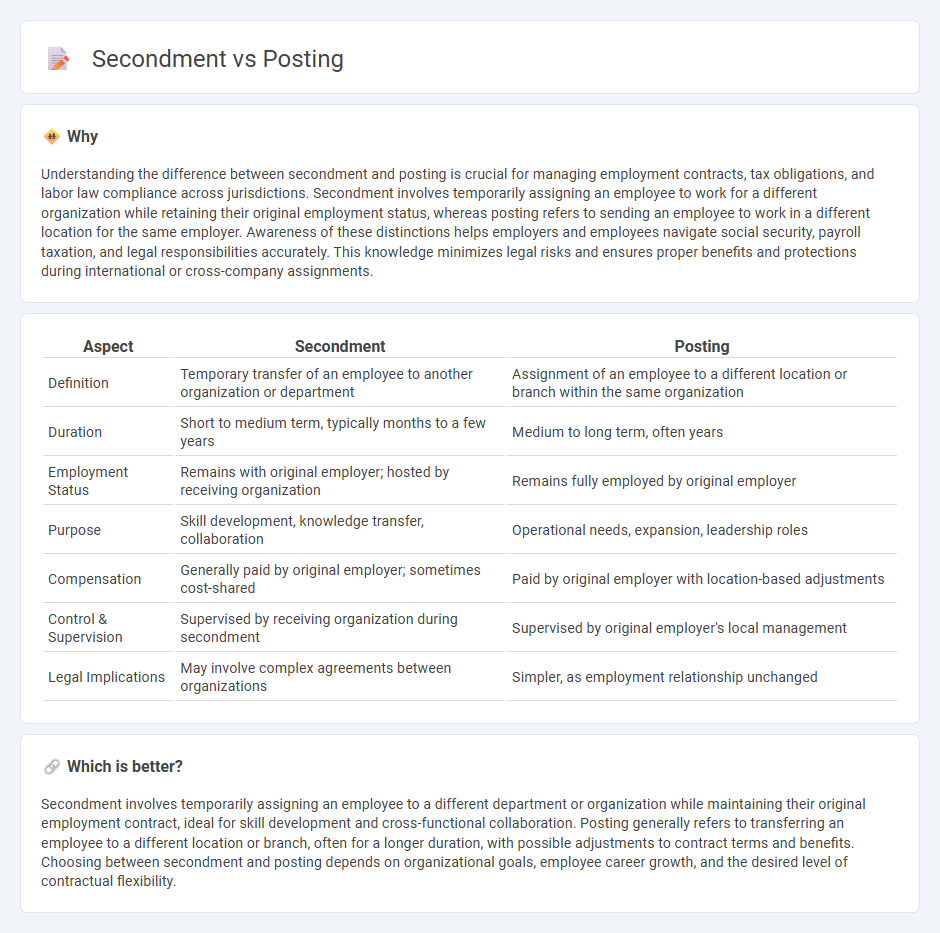
Employment arrangements often involve secondment or posting, each serving distinct organizational needs. Secondment temporarily assigns an employee to another department or organization while retaining their original employment contract, whereas posting typically involves a longer-term relocation, often to a different geographical location or subsidiary. Explore the key differences, benefits, and implications of secondment and posting to determine the best fit for your workforce strategy.
Why it is important
Understanding the difference between secondment and posting is crucial for managing employment contracts, tax obligations, and labor law compliance across jurisdictions. Secondment involves temporarily assigning an employee to work for a different organization while retaining their original employment status, whereas posting refers to sending an employee to work in a different location for the same employer. Awareness of these distinctions helps employers and employees navigate social security, payroll taxation, and legal responsibilities accurately. This knowledge minimizes legal risks and ensures proper benefits and protections during international or cross-company assignments.
Comparison Table
| Aspect | Secondment | Posting |
|---|---|---|
| Definition | Temporary transfer of an employee to another organization or department | Assignment of an employee to a different location or branch within the same organization |
| Duration | Short to medium term, typically months to a few years | Medium to long term, often years |
| Employment Status | Remains with original employer; hosted by receiving organization | Remains fully employed by original employer |
| Purpose | Skill development, knowledge transfer, collaboration | Operational needs, expansion, leadership roles |
| Compensation | Generally paid by original employer; sometimes cost-shared | Paid by original employer with location-based adjustments |
| Control & Supervision | Supervised by receiving organization during secondment | Supervised by original employer's local management |
| Legal Implications | May involve complex agreements between organizations | Simpler, as employment relationship unchanged |
Which is better?
Secondment involves temporarily assigning an employee to a different department or organization while maintaining their original employment contract, ideal for skill development and cross-functional collaboration. Posting generally refers to transferring an employee to a different location or branch, often for a longer duration, with possible adjustments to contract terms and benefits. Choosing between secondment and posting depends on organizational goals, employee career growth, and the desired level of contractual flexibility.
Connection
Secondment and posting both involve the temporary transfer of employees to different locations or organizations, enhancing skill development and knowledge exchange. In secondment, employees are temporarily assigned to another organization while remaining on their original employer's payroll, whereas posting typically refers to relocation within the same company or its subsidiaries, often internationally. Both practices support workforce flexibility and strategic deployment of talent in global employment management.
Key Terms
Employer-Employee Relationship
Posting involves temporarily assigning an employee to work in a different location or subsidiary while maintaining their original employment contract, ensuring continued alignment with the home employer's terms and conditions. Secondment typically entails a formal agreement where an employee is loaned to another organization or department, creating a tri-partite relationship that may modify reporting lines and responsibilities. Explore the distinctions between posting and secondment to optimize your international workforce management strategy.
Duration of Assignment
Posting typically involves an assignment of indefinite or long-term duration, often lasting several years at a host location, allowing employees to deeply integrate into the local work environment. Secondment, by contrast, refers to a temporary transfer usually ranging from a few months to two years, designed to fulfill specific project needs or skill development goals before returning to the original role. Explore further to understand how choosing between posting and secondment can align with your organizational strategy and employee career development.
Compensation Structure
Posting typically involves an employee working abroad while remaining on their home country's payroll, maintaining original salary and benefits with possible expatriate allowances. Secondment often entails temporary transfer to a different organization or location with compensation aligned to the host entity's pay scale, sometimes blending home and host country benefits. Explore detailed insights on compensation structures for posting and secondment to optimize employee financial planning.
Source and External Links
Posting: The API client that lives in your terminal - Posting is an open-source terminal app designed for developing and testing APIs with a powerful keyboard-centric interface, allowing features like saving requests in readable formats, autocompletion, and running on multiple platforms including over SSH on remote machines.
darrenburns/posting: The modern API client that lives in the terminal - Posting is an HTTP client similar to Postman and Insomnia but operates as a terminal UI app, enabling efficient workflows with features like jump mode, environments, syntax highlighting, custom keybindings, and the ability to run Python code before and after requests.
What is posting? Simple Definition & Meaning - Posting is the act of sharing something online, such as a message, photo, or job listing, essentially publishing content on websites or social media platforms for others to see.
 dowidth.com
dowidth.com